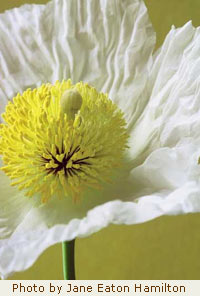Guest post by Jane Eaton Hamilton
“Black gold? Not in our composters. More like brown zirconium.”
 Organize our compost? Itemize all the stuff there is to do in the garden: cleaning up, digging, planting, fertilizing. Rearranging the beds. Dividing. Putting up seeds. Spraying for damping off. Spraying for black spot. Fence fixing. Lawn mowing. And somehow Joy and I have to get through all this on weekends. We’ve already gave up 98.7% of our leisure time to our garden, so what’s next? Give up sleep? Donating our neighbors to the task? Where do other gardeners get all their time anyhow? Joy and I barely manage to keep our heads above the compost bin. That’s us you see back there when you drive down our alley, four arms frantically waving as we sink into the effluvium.
Organize our compost? Itemize all the stuff there is to do in the garden: cleaning up, digging, planting, fertilizing. Rearranging the beds. Dividing. Putting up seeds. Spraying for damping off. Spraying for black spot. Fence fixing. Lawn mowing. And somehow Joy and I have to get through all this on weekends. We’ve already gave up 98.7% of our leisure time to our garden, so what’s next? Give up sleep? Donating our neighbors to the task? Where do other gardeners get all their time anyhow? Joy and I barely manage to keep our heads above the compost bin. That’s us you see back there when you drive down our alley, four arms frantically waving as we sink into the effluvium.
Last summer we ripped a Queen Elizabeth climbing rose out of the sun bed even though its trunk was as wide around as a child’s waist and its thorns were certifiable weapons. We took it out because it’s a ridiculous rose. Even though it was a gift, even though it grew quickly and gave us good screening, it had, during each summer’s pinnacle, only seven blooms. The trunk is still out in the alley pushed behind the unemptied composters (inside which the tottering old neighbour hides his mickeys. Imagine his wife thinking he’s just going out the door for the constitutional the doctor ordered).
We have three black plastic bins we got from the city and a chicken-wire cage we cobbled together ourselves. The perfect plan was to put the raw debris in the cage and move the composting debris over bin by bin, until, by the time it reached the last bin, it had turned itself into black gold. We thumb through the Lee Valley catalogue pining for the cool rotating bin that makes compost in the time it takes us to eat dinner. The Cadillac of composters. But even if we could afford the thing, we have no place save the dining room left to put it. Black gold? Not in our composters. More like brown zirconium.
Imagine us bothering to create layers like making lasagna, noodle, cheese, sauce. First a layer of dirt, then a layer of kitchen waste, then a layer of old leaves. Repeat. Bake at 325 degrees until the worms on top are toasted and brown. (Er, browner.)
Oh yeah, right. Not in our adequate gardener’s garden. In the adequate gardener’s garden there are two adequate gardeners, a couple ordinary, adequate thumbs (blue from the hammer) devoted to doing things with as little fooferah as we can get away with. We count ourselves successful if we even manage to gather the debris from the beds onto the lawn where it mounds until the grass underneath turns yellow. From there, we fill our multiple city recycling blue bins with cuttings and step on them to compact them, hoping against hope that maybe sometime down the way we’ll end up with wine. We get seven or eight of these containers going and when we want the garden to look half-decent on the very rare occasion we busily adequate gardeners actually have time to entertain, we stack them out of sight around the bbq, which works as long as no food needs to be cooked.
“And it all attracts snails, slugs, spiders and critters from Star Wars that take one look at our outfits and scuttle from sight.”
 We mean of course to remember to put holes in the containers so they’ll drain, but invariably we forget and have to face a floating soupy mess of brackish water and worms, which we then slop out, pouring it over our sneakers. Which, come to think of it, is the de rigeur look at our place–baseball caps, mud smears on our foreheads and cheeks, paint-smattered, filthy pants, sneakers with holes, droopy tool belts dangling green plastic garden twine the cats chase, knee pads velcroed into place, stinking like we just poured rotting worms all over ourselves.
We mean of course to remember to put holes in the containers so they’ll drain, but invariably we forget and have to face a floating soupy mess of brackish water and worms, which we then slop out, pouring it over our sneakers. Which, come to think of it, is the de rigeur look at our place–baseball caps, mud smears on our foreheads and cheeks, paint-smattered, filthy pants, sneakers with holes, droopy tool belts dangling green plastic garden twine the cats chase, knee pads velcroed into place, stinking like we just poured rotting worms all over ourselves.
This, however, is not as bad as the mix we make up for each new planting hole, a combination of bone meal, peat and compost, and which we never seem to quite finish. We leave the dregs to sit in the rain, too, not intentionally, but because it is already ten p.m. and getting dark and we haven’t even considered dinner yet, plus we have to soak in a hot tub, right, with epsom salts to untangle our muscles? So when days later one of us goes to make more and delightedly finds some already prepared and happily digs in her spade, she finds maggots, lots of maggots happily waving their creepy bobbily heads like some subterranean chorus line.
This is much like the actual composters themselves, where all manners of creatures are attracted to our unlayered kitchen refuse. We’re not all the way to inadequate–we don’t throw in bones or dairy or grains that would attract rodents (we have rodents, but only in the house), but everything else is hucked in there willy nilly. And it all attracts snails, slugs, spiders and critters from Star Wars that take one look at our outfits and scuttle from sight. But rarely does it attract red wrigglers because, of course, red wrigglers are what is needed.
Since leaves are good not only for winter mulch, but for the compost, in the fall we steal them pre-bagged from streets with maple trees. We leave the bags on the flagstone patio. Composting will take place en bag if only we throw in a couple of scoops of dirt, so we do that, only to discover in March that, yippee, they’re almost there. Woe that we can’t fit them. Still, we heave the bags to the back because, alas, we’ve managed to kill all our patio mosses and creeping thyme; we set them out behind the three overflowing composters. What do you think happens? I mean, this is where the adequate gardeners heft spades. Yup, not two days later: Stolen.
We never stir, by the way, even though we have one of those aerating gadgets that slips in with little ado, snaps open in the reeking recesses, then, when we try to lift it out catches on sticks so we have to tug, then heave, so that finally, grunting, we lift the entire composter from its base causing it to come apart at the middle seam and roll half-decayed grapefruits, oranges–and a baseball?–into the alley. Stirring the compost would inevitably lead to more chores–like actual compost, which is on a slippery slope towards the ever-so-time-consuming job of spreading compost. Our composters are filled to the brim and once the plant material subsides, as inevitably, eventually, it does, we refill and refill and refill. (Sometimes we watch from our upper porch as our gardening neighbors tug the bottom doors off and steal the stuff we’ve managed to produce. We’d get irritated, but, frankly, it just saves us work.) We continue on our inefficient way for about a year, and once in a great mountain of summer days we remembering to knock off the composter tops so we can hose down the now exceedingly dry matter inside. Which then, needless to say, gives way to yet another no-no in the perfect gardener’s garden–soggy unaerated compost. Or not soggy unaerated compost, I guess, but just soggy debris which refuses to break down, therefore saving us more time.
Okay, okay, I’m exaggerating. Once a year, give or take, in what we plan to be early spring but which usually ends up being early fall (that all-important season when plants go dormant and need a nutritional boost), we empty the composters, find all the garden tools we lost during the year snuggled in beside a broken plastic doll, a crumpled scooter and an undecayed grade three notebook (gifts, lovely gifts from the wanderers past), and fill them back up with the raw stack that’s now as tall on the mesh bin as the roof of the neighbour’s garage. We sieve (our strainer is still, after five years, waiting to be framed; the wire dangle loose at the edges) and throw it in bucketfuls towards the beds. Nope, we don’t scratch it into the surface. Nope, we don’t watch out that it doesn’t hit the crowns of perennials, even though it’s important to us that they not rot. Mind you, if they rot, it’d just be fewer plants to divide come spring.
After all of our inattention and foolish attention, the stuff that comes out of our composters–and there’s lots of it– is compost, just the same. Crumbly, friable, brownish. And it’s on the beds, more or less where it should be. Now if only we could find a minute to put up our feet and smugly appreciate it.
Jane Eaton Hamilton is the award-winning author of four books. She grew up in Ontario, lived in St. Louis, Phoenix, NYC, Alberta, the Kootenays and on Salt Spring Island before settling in Vancouver. You can find out more about her at http://janeeatonhamilton.wordpress.com.